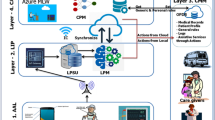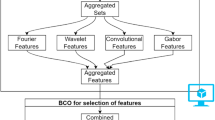Abstract
Nowadays, various social media platforms, as well as wearable sensor devices, play a significant role in collecting data from patients for effective healthcare monitoring. However, continuous monitoring of patients using wearable sensor devices generates a huge amount of data and can be a complicated task to analyze efficiently. Therefore, this paper proposes a novel framework called Biased ReLU Neural Network-based Cat Hunting Optimization (BRNN-CHO) to classify the health condition of the patient. The proposed system consists of five phases: the data source phase, data collection phase, data pre-analysis phase, data pre-processing phase, and data classification phase. In the data source layer, various heterogeneous data including various medical records, social media platforms, and wearable sensor devices are addressed. The second data collection phase collects data regarding patients with blood pressure and diabetes. Then, in the data storage phase, the data collected from various medical records, social media platforms, and wearable sensor devices are uploaded to the big data cloud center. After uploading, the data is pre-analyzed and pre-processed to extract unwanted data. Finally, the pre-processed data is classified using BRNN-CHO to determine the health condition of the patient related to mental health, diabetes, and blood sugar, as well as blood pressure, with an enhanced accuracy rate. Experimental analysis is carried out and compared with various state-of-the-art techniques to determine the efficiency of the proposed system. When compared in terms of accuracy, F-measure, precision, and recall, the proposed BRNN-CHO model offers higher performance. The accuracy, recall, precision, and F1-measure of the proposed model are nearly equal to 95%, 90%, 92%, and 93%. The Root mean square error (RMSE), Mean absolute error (MAE), execution time, and latency of the proposed model are 30, 12, 1.38 s, and 1.8 s, respectively.













Similar content being viewed by others
Data availability
Data sharing is not applicable to this article as no new data were created or analyzed in this study.
References
Moro Visconti, R., & Morea, D. (2020). Healthcare digitalization and pay-for-performance incentives in smart hospital project financing. International journal of environmental research and public health, 17(7), 2318.
Rawson, T. M., Wilson, R. C., O’Hare, D., Herrero, P., Kambugu, A., Lamorde, M., Ellington, M., Georgiou, P., Cass, A., Hope, W. W., & Holmes, A. H. (2021). Optimizing antimicrobial use: Challenges, advances, and opportunities. Nature Reviews Microbiology, 19(12), 747–758.
Guk, K., Han, G., Lim, J., Jeong, K., Kang, T., Lim, E. K., & Jung, J. (2019). Evolution of wearable devices with real-time disease monitoring for personalized healthcare. Nanomaterials, 9(6), 813.
Pathak, N., Misra, S., Mukherjee, A., & Kumar, N. (2021). HeDI: healthcare device interoperability for IoT-based e-health platforms. IEEE Internet of Things Journal, 8(23), 16845–16852.
Zheng, Y., Lu, R., Zhang, S., Guan, Y., Shao, J., & Zhu, H. (2021). Toward privacy-preserving healthcare monitoring based on time-series activities over cloud. IEEE Internet of Things Journal, 9(2), 1276–1288.
Adiono, T., Ahmadi, N., Saraswati, C., Aditya, Y., Yudhanto, Y. P., Aziz, A., Wulandari, L., Maranatha, D., Khusnurrokhman, G., Riadi, A. R. W., & Sudjud, R. W. (2022). Respinos: a portable device for remote vital signs monitoring of COVID-19 patients. IEEE Transactions on Biomedical Circuits and Systems, 16(5), 947–961.
Fang, K. Y., Ginige, J. A., Basilakis, J., Bjering, H., & Javadi, B. (2022). Smart homecare research translation into broader practice: enablers, barriers and directions. IEEE Access, 10, 134726–134743.
Pantelopoulos, A., & Bourbakis, N. G. (2010). Prognosis—a wearable health-monitoring system for people at risk: Methodology and modeling. IEEE Transactions on Information Technology in Biomedicine, 14(3), 613–621.
Ng, C. L., Reaz, M. B. I., & Chowdhury, M. E. H. (2019). A low noise capacitive electromyography monitoring system for remote healthcare applications. IEEE Sensors Journal, 20(6), 3333–3342.
Dey, N., Ashour, A. S., Shi, F., Fong, S. J., & Sherratt, R. S. (2017). Developing residential wireless sensor networks for ECG healthcare monitoring. IEEE Transactions on Consumer Electronics, 63(4), 442–449.
Wang, C., Zhou, J., Liao, L., Lan, J., Luo, J., Liu, X., & Je, M. (2014). Near-threshold energy-and area-efficient reconfigurable DWPT/DWT processor for healthcare-monitoring applications. IEEE Transactions on Circuits and Systems II: Express Briefs, 62(1), 70–74.
Reibling, N., Ariaans, M., & Wendt, C. (2019). Worlds of healthcare: A healthcare system typology of OECD countries. Health Policy, 123(7), 611–620.
Mabdeh, A. N., Ahmadlou, M., Al-Adamat, R., & Al-Shabeeb, A. R. (2022). GIS-based landslide susceptibility assessment and mapping in Ajloun and Jerash governorates in Jordan using genetic algorithm-based ensemble models. Acta Geophysica, 70(3), 1253–1267.
Mohan, S., Thirumalai, C., & Srivastava, G. (2019). Effective heart disease prediction using hybrid machine learning techniques. IEEE access, 7, 81542–81554.
Palanisamy, V., & Thirunavukarasu, R. (2019). Implications of big data analytics in developing healthcare frameworks–A review. Journal of King Saud University-Computer and Information Sciences, 31(4), 415–425.
Vellido, A. (2020). The importance of interpretability and visualization in machine learning for applications in medicine and health care. Neural computing and applications, 32(24), 18069–18083.
Morariu, C., Morariu, O., Răileanu, S., & Borangiu, T. (2020). Machine learning for predictive scheduling and resource allocation in large-scale manufacturing systems. Computers in Industry, 120, 103244.
Ravikumar, S., & Kavitha, D. (2021). IoT based home monitoring system with secure data storage by Keccak–Chaotic sequence in cloud server. Journal of Ambient Intelligence and Humanized Computing, 12, 7475–7487.
Kavitha, D., & Ravikumar, S. (2021). IOT and context-aware learning-based optimal neural network model for real-time health monitoring. Transactions on Emerging Telecommunications Technologies, 32(1), e4132.
Maragathavalli, P., & Vivitha, M. R. (2021). Smartphone sensor-based human activity recognition system using BRNN-LSTM method. International Research Journal of Engineering and Technology, 8(7), 483–492.
Silva, F. A., Nguyen, T. A., Fé, I., Brito, C., Min, D., & Lee, J. W. (2021). Performance evaluation of an internet of healthcare things for medical monitoring using M/M/c/K queuing models. IEEE Access, 9, 55271–55283.
Amin, S. U., Hossain, M. S., Muhammad, G., Alhussein, M., & Rahman, M. A. (2019). Cognitive smart healthcare for pathology detection and monitoring. IEEE Access, 7, 10745–10753.
Yu, L., Chan, W. M., Zhao, Y., & Tsui, K. L. (2018). Personalized health monitoring system of elderly wellness at the community level in Hong Kong. IEEE Access, 6, 35558–35567.
Kaur, P., Kumar, R., & Kumar, M. (2019). A healthcare monitoring system using random forest and internet of things (IoT). Multimedia Tools and Applications, 78, 19905–19916.
Pustokhin, D. A., Pustokhina, I. V., Rani, P., Kansal, V., Elhoseny, M., Joshi, G. P., & Shankar, K. (2021). Optimal deep learning approaches and healthcare big data analytics for mobile networks toward 5G. Computers & Electrical Engineering, 95, 107376.
Yang, X., McEwen, R., Ong, L. R., & Zihayat, M. (2020). A big data analytics framework for detecting user-level depression from social networks. International Journal of Information Management, 54, 102141.
Kavuncuoğlu, E., Uzunhisarcıklı, E., Barshan, B., & Özdemir, A. T. (2022). Investigating the performance of wearable motion sensors on recognizing falls and daily activities via machine learning. Digital Signal Processing, 126, 103365.
Xing, Y., Wang, X., Qiu, C., Li, Y., & He, W. (2022). Research on opinion polarization by big data analytics capabilities in online social networks. Technology in Society, 68, 101902.
Motwani, A., Shukla, P. K., & Pawar, M. (2021). Novel framework based on deep learning and cloud analytics for smart patient monitoring and recommendation (SPMR). Journal of Ambient Intelligence and Humanized Computing. https://doi.org/10.1007/s12652-020-02790-6
Ali, F., El-Sappagh, S., Islam, S. R., Ali, A., Attique, M., Imran, M., & Kwak, K. S. (2021). An intelligent healthcare monitoring framework using wearable sensors and social networking data. Future Generation Computer Systems, 114, 23–43.
Pomare, C., Long, J. C., Churruca, K., Ellis, L. A., & Braithwaite, J. (2019). Social network research in health care settings: Design and data collection. Social Networks, 69, 14–21.
Serban, O., Thapen, N., Maginnis, B., Hankin, C., & Foot, V. (2019). Real-time processing of social media with SENTINEL: A syndromic surveillance system incorporating deep learning for health classification. Information Processing & Management, 56(3), 1166–1184.
Pai, M. M., Ganiga, R., Pai, R. M., & Sinha, R. K. (2021). Standard electronic health record (EHR) framework for Indian healthcare system. Health Services and Outcomes Research Methodology, 21(3), 339–362.
Liang, X., & Xu, J. (2021). Biased ReLU neural networks. Neurocomputing, 423, 71–79.
Ghaedi, A., Bardsiri, A.K. and Shahbazzadeh, M.J., 2021. Cat hunting optimization algorithm: a novel optimization algorithm. Evolutionary Intelligence, pp.1–22.
Hakim, M., Omran, A. A. B., Ahmed, A. N., Al-Waily, M., & Abdellatif, A. (2022). A systematic review of rolling bearing fault diagnoses based on deep learning and transfer learning: Taxonomy, overview, application, open challenges, weaknesses and recommendations. Ain Shams Engineering Journal, 14, 101945.
Bansal, M., Goyal, A., & Choudhary, A. (2022). A comparative analysis of K-nearest neighbour, genetic, support vector machine, decision tree, and long short term memory algorithms in machine learning. Decision Analytics Journal, 3, 100071.
Acknowledgements
The authors are grateful to all respondents who participated in this study and to the data collectors for their contribution.
Author information
Authors and Affiliations
Contributions
All authors who participated in data analysis, drafting or revising the manuscript gave approval of the final version to be published.
Corresponding author
Ethics declarations
Conflict of interest
The authors declare that they have no conflicts of interest.
Additional information
Publisher's Note
Springer Nature remains neutral with regard to jurisdictional claims in published maps and institutional affiliations.
Rights and permissions
Springer Nature or its licensor (e.g. a society or other partner) holds exclusive rights to this article under a publishing agreement with the author(s) or other rightsholder(s); author self-archiving of the accepted manuscript version of this article is solely governed by the terms of such publishing agreement and applicable law.
About this article
Cite this article
Dhanushkodi, K., Sethuraman, R., Mariappan, P. et al. An efficient cat hunting optimization-biased ReLU neural network for healthcare monitoring system. Wireless Netw 29, 3349–3365 (2023). https://doi.org/10.1007/s11276-023-03373-x
Accepted:
Published:
Issue Date:
DOI: https://doi.org/10.1007/s11276-023-03373-x




